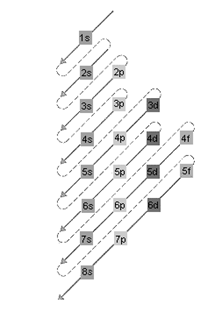
Concept explainers
(a)
Interpretation: The elements with the given electronic configuration should be identified as a metal, non-metal or metalloid.
Concept Introduction: The elements which can donate electrons to get the stable electronic configuration are metal, elements that can accept electrons are non-metal. The elements with characteristics of both metals and non-metals are metalloids.
(b)
Interpretation: The element with the smallest atomic size should be identified.
Concept Introduction: According to the periodic trends, the atomic size of the element increases on moving top to bottom in a group due to addition of one shell and decreases on moving left to right in a group due to increase in
(c)
Interpretation: The element with the highest ionization energy should be identified.
Concept Introduction: Ionization energy is defined as the amount of energy required to remove an electron from its outermost shell. According to periodic trends, it decreases on moving top to bottom in a group due to increase in size and it increases on moving left to right in a period due to decrease in size.
(d)
Interpretation: The element with the half-filled sublevel should be identified.
Concept Introduction: The relative energy of orbitals is represented as follows:

A s orbital can have maximum of 2 electrons, p orbital can have maximum of 6 electrons. Similarly, maximum electrons that a d and f orbital can have are 10 and 14 respectively.
Want to see the full answer?
Check out a sample textbook solution
Chapter 5 Solutions
EP BASIC CHEMISTRY-STANDALONE ACCESS
- Please correct answer and don't use hand ratingarrow_forwardHow might you prepare each of the following using a nucleophilic substitution reaction at some step? (a) (b) (c) (d) CH3 CH3C CCHCH3 CH3 CH3 0 CCH3 ☐ CH3 CH3CH2CH2CH2CN CH3CH2CH2NH2arrow_forwardNo AI response. Please reference attachment for assistance with chemistry. Will upvote if satisfied. Thanks againarrow_forward
- Manganese(II) Arsenate is insoluble in water at room temperature. (Note: Arsenate = AsO4³-) In the presence of aqueous ammonia, solid Manganese(II) Arsenate becomes more soluble and aqueous tetraamminemanganese (II) ion forms. When solid Manganese(II) arsenate was placed in a 2.00 M solution of ammonia, at equilibrium, 0.308 M of ammonia remains. If the Kf of tetraamminemanganese (II) ion is 250.0, Determine the Ksp of Manganese(II) arsenate Hint: You will have to figure out the Kspf of the overall chemical equation first, then solve for Ksp by using Kf and Kspfarrow_forwardNeed assistance with the following chemistry problem. I will upvote if satisifed. No AI response please. Thanks again.arrow_forwardNo AI response. I need assistance with the following chemistry problem. I will upvote if satisfied. Thank youarrow_forward
- Hello, I need assistance with this chemistry problem. It is regarding Clausius-Clapeyronarrow_forwardPlease correct answer and don't use hand rating and don't use Ai solutionarrow_forward4. Draw the major 1,2- and 1,4-addition products of the following reactions? For each reaction indicate the kinetic and the thermodynamic products (1 a) b) HBr HBr ROOR ROORarrow_forward
- The vibrational energy level of CO molecule is given by the expression Ev (in J mol¹) = 25000 (v+%) -150 (v + 2)² where v is the vibrational quantum number. Calculate the force constant (in N m¹) (Answer up to two decimal places) [4]arrow_forwardPlease don't use Ai solutionarrow_forward(please correct answer and don't use hand rating) Organic chemistry: Predict the product for the reaction below:arrow_forward
 Chemistry & Chemical ReactivityChemistryISBN:9781133949640Author:John C. Kotz, Paul M. Treichel, John Townsend, David TreichelPublisher:Cengage Learning
Chemistry & Chemical ReactivityChemistryISBN:9781133949640Author:John C. Kotz, Paul M. Treichel, John Townsend, David TreichelPublisher:Cengage Learning Chemistry & Chemical ReactivityChemistryISBN:9781337399074Author:John C. Kotz, Paul M. Treichel, John Townsend, David TreichelPublisher:Cengage Learning
Chemistry & Chemical ReactivityChemistryISBN:9781337399074Author:John C. Kotz, Paul M. Treichel, John Townsend, David TreichelPublisher:Cengage Learning

